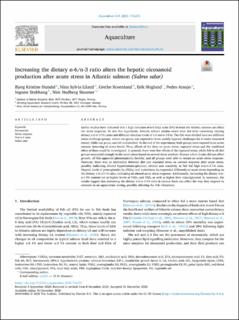| dc.contributor.author | Hundal, Bjørg Kristine | |
| dc.contributor.author | Liland, Nina Sylvia | |
| dc.contributor.author | Rosenlund, Grethe | |
| dc.contributor.author | Höglund, Erik | |
| dc.contributor.author | Araujo, Pedro | |
| dc.contributor.author | Stubhaug, Ingunn | |
| dc.contributor.author | Sissener, Nini | |
| dc.date.accessioned | 2021-07-15T14:30:23Z | |
| dc.date.available | 2021-07-15T14:30:23Z | |
| dc.date.created | 2021-03-10T16:14:44Z | |
| dc.date.issued | 2021 | |
| dc.identifier.citation | Aquaculture. 2021, 534, 736272. | en_US |
| dc.identifier.issn | 0044-8486 | |
| dc.identifier.uri | https://hdl.handle.net/11250/2764574 | |
| dc.description.abstract | Earlier studies have indicated that a high inclusion of n-6 fatty acids (FA) in feeds for Atlantic salmon can affect the stress response. To test this hypothesis, Atlantic salmon (Salmo salar) were fed diets containing varying dietary n-6/n-3 FA ratios and different absolute levels of n-6 and n-3 FAs. The fish were divided into two different stress challenge groups, where one group was exposed to three weekly hypoxia challenges for 4 weeks (repeated stress), while one group was left undisturbed. At the end of the experiment, both groups were exposed to an acute stressor (lowering of water level). Thus, effects of the diets on acute stress, repeated stress and the combined effect of these could be investigated. In general, there were few effects of the repeated stress, while fish in all diet groups responded strongly to the acute stress based on several stress markers. Dietary n-6/n-3 ratio did not affect growth, all fish appeared phenotypically healthy, and all groups were able to mount an acute stress response. However, there was an interaction between diet and repeated stress on cortisol response after acute stress, possibly indicating altered hypothalamic-pituitary adrenal axis reactivity in fish fed high n-6/n-3 FA ratio. Hepatic levels of prostaglandin D2 (PGD2) and leukotriene B4 responded differently to acute stress depending on the dietary n-6/n3 FA ratio, indicating an altered acute stress response. Additionally, increasing the dietary n-6/n-3 FA content led to higher levels of PGD2 and PGE2 as well as higher liver triacylglycerol. In summary, the results suggest that increasing the dietary n-6/n-3 FA ratio in salmon feeds can affect the way they respond to stressors in an aquaculture setting, possibly affecting the fish robustness. | en_US |
| dc.language.iso | eng | en_US |
| dc.publisher | Elsevier | en_US |
| dc.rights | Navngivelse 4.0 Internasjonal | * |
| dc.rights.uri | http://creativecommons.org/licenses/by/4.0/deed.no | * |
| dc.title | Increasing the dietary n-6/n-3 ratio alters the hepatic eicosanoid production after acute stress in Atlantic salmon (Salmo salar) | en_US |
| dc.type | Peer reviewed | en_US |
| dc.type | Journal article | en_US |
| dc.description.version | publishedVersion | en_US |
| dc.rights.holder | © 2020 The Authors. | en_US |
| dc.source.pagenumber | 12 | en_US |
| dc.source.volume | 534 | en_US |
| dc.source.journal | Aquaculture | en_US |
| dc.identifier.doi | 10.1016/j.aquaculture.2020.736272 | |
| dc.identifier.cristin | 1897069 | |
| dc.relation.project | Norges forskningsråd: 273215 | en_US |
| dc.relation.project | Fiskeri- og havbruksnæringens forskningsfinansiering: 901282 | en_US |
| dc.source.articlenumber | 736272 | en_US |
| cristin.ispublished | true | |
| cristin.fulltext | original | |
| cristin.qualitycode | 2 | |

